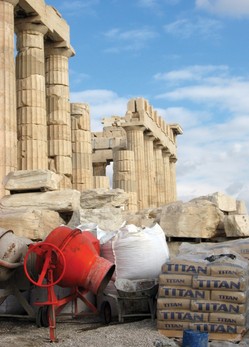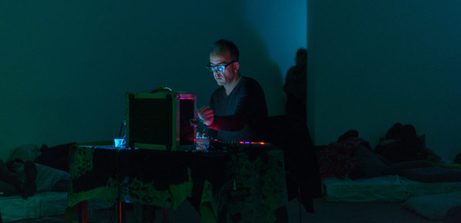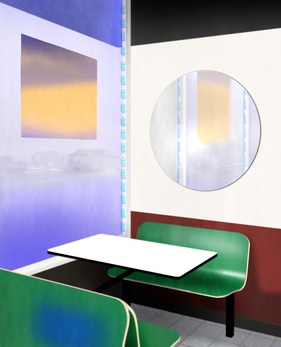Madlener House
4 West Burton Place
Chicago, Illinois 60610
Telephone: 312.787.4071
info@grahamfoundation.org

The marble workers laboring on the decades‐long restoration of the Acropolis are inheritors of a millennia-old tradition. Their work is a highly technical amalgam of past and present, yet what these master marble carvers do and how they do it has been undocumented until now. As the restoration enters its final phases, On the Rock: The Acropolis Interviews reveals the marble workers’ techniques, training, and roles within the restoration in the their own frank, deeply personal voices, as interviewed by Graham grantee Allyson Vieira. The interviews address ancient building practices, the teaching of traditional craft, changes in the practice of architectural restoration, and social and class dynamics within the restoration site, while considering Greece’s economic crisis from the workers’ perspective. How has the Greek crisis affected the technicians’ thoughts about their craft, jobs, and citizenship? Vieira will explore the intersection of these issues in conversation with Terri Kapsalis, author of a recently completed novel set in Athens.
Artist Allyson Vieira lives and works in New York. She has exhibited extensively both internationally and in the US, including institutional projects at Kunsthalle Basel (Basel), Swiss Institute (NY), Storm King Art Center (NY), PinchukArtCentre (Kiev), Non-Objectif Sud (Tulette), Frieze Projects (NY), The Public Art Fund (NY), The Highline (NY), and SculptureCenter (NY), and recent solo gallery exhibitions at Daniel Faria (Toronto), Company (NY), Klaus von Nichtssagend (NY), Mendes Wood DM (Sao Paulo, BR), The Breeder (Athens), and Laurel Gitlen (NY). Her first major catalog, Allyson Vieira: The Plural Present, was published by Karma Books in 2016. She is currently assistant professor of foundations at the Corcoran School of Art at the George Washington University in Washington, DC.
Terri Kapsalis is a writer and performer. She is the author of Jane Addams' Travel Medicine Kit, The Hysterical Alphabet, and Public Privates: Performing Gynecology from Both Ends of the Speculum. Her writings have appeared on Lit Hub and in various edited volumes and journals including Short Fiction, The Baffler, Denver Quarterly, New Formations, Public, and Parakeet. Along with John Corbett and Anthony Elms, she coedited Traveling the Spaceways: Sun Ra, the Astro Black, and Other Solar Myths and Pathways to Unknown Worlds: Sun Ra, El Saturn, and Chicago’s Afro-futurist Underground and cocurated the touring Sun Ra exhibition Pathways to Unknown Worlds. As an improvising violinist, Kapsalis' discography includes work with Tony Conrad, David Grubbs, Mats Gustafsson, Junko, and Thurston Moore. She is a founding member of Theater Oobleck and has performed in over thirty productions since 1985. Since 1991, she is a collective member and health educator at the Chicago Women's Health Center and cofounded TGAP (Trans Greater Access Project) and the Integrative Health Program. She teaches at the School of the Art Institute of Chicago.
Soberscove Press seeks to make available art-related materials that fill a gap in the literature or are difficult to access. Our books tend to explore modes and functions of documentation and connect historical themes and issues to the present. Soberscove also works with artists on the production of books that resonate with our list.
Image: Work on the Parthenon continues as part of the decades‐long Acropolis restoration project. Photo: Allyson Vieira
For more information on the exhibition, Spirit of the Waves, click here.

Hitler at Home examines the aesthetic and ideological construction of Hitler's domesticity, focusing on his two private residences in Bavaria: the Berghof on the Obersalzberg and his Munich apartment at Prinzregentenplatz 16. Through the architectural and media creation of these places, the Nazi regime fostered the myth of the private Hitler as peaceable homebody and good neighbor, an image used strategically and effectively within Germany and abroad to distance the Führer from Europe's violence. Moreover, this image helped to dispel any suspicions raised by the Führer’s bachelor status that may have threatened the Nazi cult of domesticity. Largely ignored by historians as politically or architecturally insignificant, the fabrication of Hitler's private spaces reveals how the occupant imagined his interiority, how he positioned this self in relation to his public identity, and how intricately and expertly artists and propagandists of the regime interwove these facets into a seductive whole.
Despina Stratigakos is SUNY Buffalo’s vice provost for inclusive excellence and professor of architecture in the Department of Architecture. She is the author of three books that explore the intersections of power and architecture, including Where Are the Women Architects? (Princeton University Press, 2016), and Hitler at Home (Yale University Press, 2015). She is currently writing a book on the Nazis’ building plans for occupied Norway (forthcoming 2020). Stratigakos is a Graham Foundation grantee has served as a director of the Society of Architectural Historians, an advisor of the International Archive of Women in Architecture at Virginia Tech, and a trustee of the Beverly Willis Architecture Foundation in New York.
Related Graham supported projects:
2015 grant to Despina Stratigakos for the publication Hitler at Home
2010 grant to Despina Stratigakos for research on the publication Hitler at Home
Image: Left: Heinrich Hoffmann, postcard of the Berghof, Hitler’s mountain home on the Obersalzburg, ca. 1936. Right: Heinrich Hoffmann, photograph of Hitler escorting a girl to his Obersalzburg house, from Hoffmann’s Youth around Hitler (1934).
For more information on the exhibition, Spirit of the Waves, click here.

This Ain’t My First Rodeo explores the psychoacoustic interactions between two synthesizers in quad sound, with additional material generated and mutated by 1/4-inch tape delay. Anthony Pateras’ new project wraps listeners in an extraordinary sensory experience of musical illusions.
The title itself also may be deceptive. Pateras is no novice, after more than 20 years on the scene. But don’t read the work as any kind of boast. Instead, the rodeo reference is akin to the turbulent self-reinvention he went through when starting this piece, which he reveals last happened when he wrote "Blood Stretched Out" for Lampo in 2014.
Pateras finds inspiration in the words of poet Adrienne Rich: “All new learning looks at first like chaos.”
“Music is so mysterious. When you find something that works, you can be very tempted to keep doing the same thing,” says the Australian composer.
“I tend to get bored and look for a new take or approach. It feels very chaotic, but I remind myself that’s what you always have to go through. This seems to be the ideal state for a musician to do a good job—terrified curiosity.”
Anthony Pateras is a composer and performer whose current work focuses on electroacoustic orchestration, temporal hallucination and sound phenomena. Pateras has created over 75 works, receiving performances from the Los Angeles Philharmonic, Australian Chamber Orchestra and BBC Symphony; commissions from the GRM, Slagwerk Den Haag and Südwestrundfunk Baden-Baden; residencies from ZKM, Akademie Schloss Solitude and La Becque; and fellowships from Creative Victoria, and the Ian Potter and Sydney Myer Foundations. He has released over 40 albums including collaborations with Mike Patton, Stephen O’Malley and Valerio Tricoli. Aside from solo concerts, he currently performs with eRikm, Jérôme Noetinger and Erkki Veltheim.
Pateras made his Chicago debut for Lampo and the Graham Foundation in May 2011.
Since 2010 the Graham Foundation has supported and partnered with Lampo to produce this performance series held at the Madlener House. Lampo, founded in 1997, is a non-profit organization for experimental music and intermedia projects.
Image: Courtesy of the artist.

Join us for a reception with artist Nelly Agassi to celebrate the opening of her new exhibition Spirit of the Waves.
Through a newly commissioned body of work, including a large-scale textile installation, intricate embroideries, works on paper, sculptures, and a performance, Nelly Agassi conjures historical and imagined narratives from the architectural details of the Graham Foundation’s Madlener House. Built in 1901–02 for Albert F. and Elsa S. Madlener, the house was originally designed by architect Richard E. Schmidt, with designer Hugh M. G. Garden, and then renovated in the 1960s by architect Daniel Brenner to transform it into the Foundation’s headquarters. The culmination of Agassi’s 2019 Graham Foundation Fellowship, this exhibition explores erasure, preservation, identity, and architecture’s capacity to change.
Chicago-based artist Nelly Agassi (b.1973, Israel) received her MFA from Chelsea College and her BFA from Central St. Martins, both in London. Her work has been shown internationally at institutions and galleries such as The Arts Club of Chicago, Aspect Ratio, Hyde Park Art Center, The Israel Museum, Poor Farm, Tate Modern, Tel Aviv Museum of Art, La Triennale di Milano, and Zacheta Warsaw. Agassi is a cofounder of the nonprofit organization Fieldwork Collaborative Projects and a 2019 Graham Foundation Fellow. She is represented by Dvir Gallery and Foksal Gallery.
Agassi worked with Hand and Lock embroidery house in London and The Weaving Mill in Chicago to produce works in the exhibition.
Hand & Lock are London’s premier embroidery house providing embellishment services to the Royal Family, top European design houses, the Royal Armed Forces, Savile Row and members of the public.
The Weaving Mill is an experimental weaving studio in Chicago’s Humboldt Park that blends design, fine art, textile education, and research-based practice.
Spirit of the Waves is commissioned by the Graham Foundation and organized by director Sarah Herda and Ellen Alderman, deputy director of exhibitions and public programs, with James Pike and Ava Barrett. Special thanks to Lori Hanna Boyer and Christopher Rosenberg, Department of Architecture and Design, The Art Institute of Chicago; Jaime Fuentes; Chandra Goldsmith Gray; Scott Heron and Jessica Jane, Hand & Lock; Sharon Hoyer, High Concept Labs; Duncan Jackson and Simon Kristak, Billings Jackson Design; Jennifer Keats, Service Bureau, School of the Art Institute of Chicago; Lauren Mack; Peter Maunu; Ryan Packard; Nathaniel Parks, Ryerson & Burnham Libraries, The Art Institute of Chicago; Emily Frances Winter, The Weaving Mill; and the Graham Foundation staff: Vidisha Aggarwal, Alexandra Drexelius, Carolyn Kelly, Ron Konow, Junxi Lu, and Alexandra Small.
Image: Nelly Agassi, Plot, 2019. Digital manipulation of the 1967 Madlener House plans drawn for the Historic American Buildings Survey. Courtesy of the artist and Graham Foundation, Chicago.
For more information on the exhibition, Spirit of the Waves, click here.

As the Douglas A. Garofalo Fellow from the University of Illinois at Chicago (UIC) School of Architecture, Anne Dessing has researched architectural elements that divide space, such as walls, doors, windows, columns, fences, arches, and gates.
Through a pictorial essay of architectural elements and surfaces from Detroit, St. Louis, and Chicago, Dessing shares her observations as stories of surreal situations in the Midwest. This talk supplements the exhibition of the same name currently on view at the UIC School of Architecture until May 10.
Anne Dessing is an architect based in Amsterdam. Since graduating from the Amsterdam Academy of Architecture in 2012, she has been awarded grants from the Creative Industries Fund NL and the Prince Bernhard Cultural Foundation. Her practice, Studio Anne Dessing, operates at the intersection of art and architecture, and she researches architecture through exhibitions, installations, drawings, models, interiors, and (temporary) buildings. Dessing has taught at the Academy of Architecture in Amsterdam and Rotterdam, the Rietveld Academy, and the Chair of Interiors Buildings Cities at TU Delft.
About the Douglas A. Garofalo Fellowship
Named in honor of architect and educator Doug Garofalo (1958–2011), this nine-month teaching fellowship—supported with a grant from the Graham Foundation—provides emerging designers the opportunity to teach studio and seminar courses in the undergraduate and graduate programs and conduct independent design research. The fellowship also includes a public lecture at the Graham Foundation and an exhibition at the UIC School of Architecture. To learn more about the fellowship, click here.
Image: Anne Dessing, Harold’s Chicken Shack W 87th St, rendering, 2019
Unless otherwise noted,
all events take place at:
Madlener House4 West Burton Place, Chicago
GALLERY AND BOOKSHOP HOURS
2025 Chicago Architecture Biennial
SHIFT: Architecture in Times of Radical Change
Sep 19, 2025–Feb 28, 2026
Wed–Sat, 12–5 p.m.
To make an appointment, email: bookshop@grahamfoundation.org
CONTACT
312.787.4071
info@grahamfoundation.org
Accessibility
Events are held in the ballroom on the third floor which is only accessible by stairs.The first floor of the Madlener House is accessible via an outdoor lift. Please call 312.787.4071 to make arrangements.
Copyright © 2008–2025 Graham Foundation. All rights reserved.
 PREVIOUS POSTS
PREVIOUS POSTS